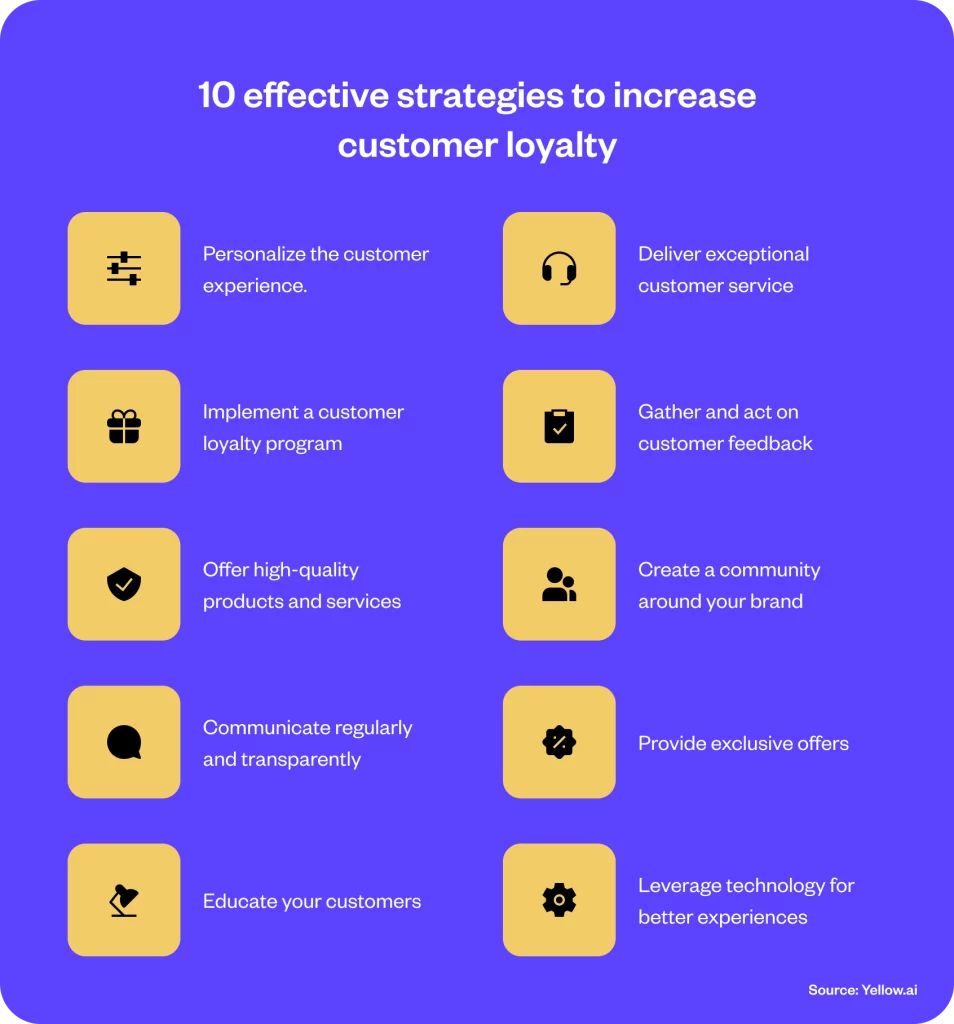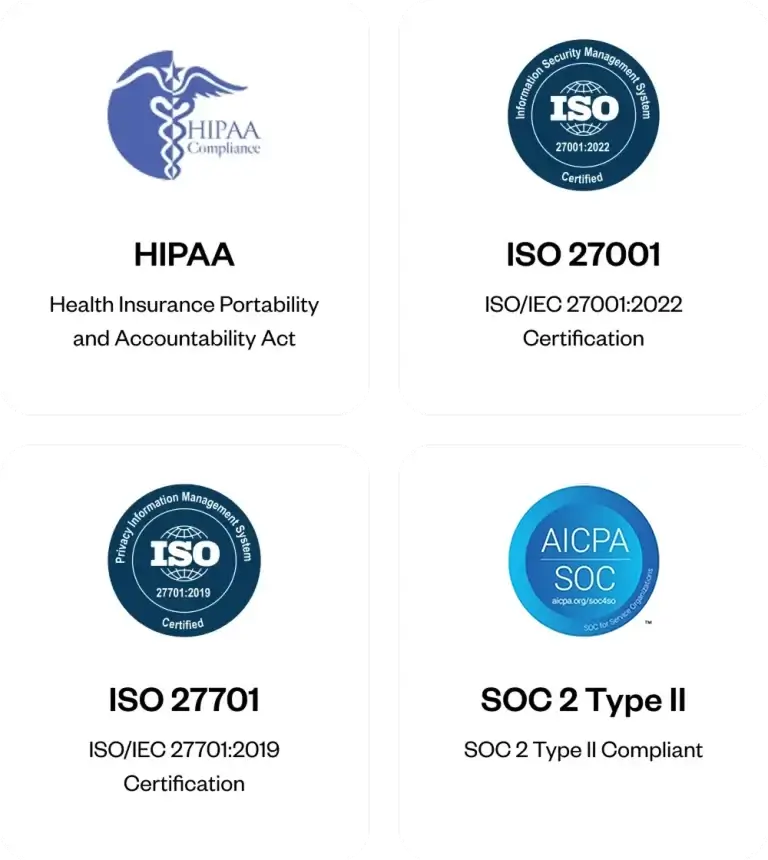Executive summary
Dive into the essence of customer loyalty with this definitive guide, where we define customer loyalty, explore compelling customer loyalty examples, and illuminate the path to achieving it. Understand the profound impact of fostering strong customer relationships and the strategic approaches to amplify loyalty within your business landscape. This blog is your blueprint for navigating the complexities of customer affinity, presenting actionable insights and methodologies to grasp customer loyalty and master its cultivation for sustained business success.
Reflect for a moment on your last memorable purchase. If you are an Apple aficionado, chances are you didn’t second-guess where to buy your next gadget. Apple doesn’t just sell tech; they sell an experience encapsulated in reliability and top-notch service. That’s customer loyalty at its core. It showcases that when a brand becomes more than a choice, it becomes a preference. In today’s market, fostering such loyalty is less about the transaction and more about the emotional connection. It’s this bond that successful companies have mastered, transforming customers into brand zealots.
But how does a business achieve this level of devotion? The answer is evolving. With AI’s emergence, the game of building customer loyalty has shifted. Now, it’s about leveraging technology to understand and predict customer needs and offering tailor-made experiences that resonate on a personal level. It is beyond just about keeping your customers coming back. Instead, it’s about making them feel like they’re part of your brand’s journey. Drawing from successful strategies and integrating AI insights, we’ll explore how to keep your loyal customer base engaged and excited about what’s next. Read on to understand the art and science of building customer loyalty, where every business can learn to turn customers into advocates with the right approach and innovative tools like those provided by Yellow.ai.
Related must-reads:
- Customer service automation – A full guide
- Omnichannel customer service – [Strategy + Examples]
- Customer service best practices to follow in 2024
- Customer service software: How to select the best one
What is customer loyalty?
Understanding customer loyalty is crucial for any business aiming to thrive in today’s competitive environment. Simply put, customer loyalty means that a person consistently chooses your brand over others, not swayed by factors like price or availability. They prefer the familiar quality and service they trust, even if it costs a bit more.
In a landscape saturated with choices, customer loyalty is the result of a company’s relentless pursuit of exceeding expectations. According to a study, a staggering 83% of customers attribute their brand loyalty to trust. It underscores a critical insight: loyalty is rooted deeply in the reliability of the product and the integrity of the brand itself. Trust becomes the foundation upon which repeat purchases are built. It propels customers beyond mere transactions into genuine brand advocates. These customers do not merely return; they become vocal champions of the brand, bringing others into the fold through their endorsements.
Building a loyal customer base demands more than just high-quality products or services. Brands that build customer loyalty craft experiences that leave a lasting impression. Loyal customers are those who are so ingrained with your brand that they see no viable alternative, regardless of price fluctuations or market dynamics. They are the ones who consistently engage, provide invaluable feedback, and stand by your brand. That is how they become an integral part of your brand’s narrative. For businesses, cultivating such loyalty is a strategic imperative. It forms the backbone of sustainable growth and a resilient brand reputation in an ever-evolving market landscape.
The importance of customer loyalty
Understanding the pivotal role of customer loyalty is just like unlocking a treasure chest for businesses. Besides just repeat purchases, it is about fostering an environment where customers choose your brand, time and again, over any other option available to them. But what elevates customer loyalty from a nice-to-have to an essential asset for brands? The answer lies in the tangible benefits it delivers, benefits that are both measurable and profound.

1. Enhances customer retention
The adage that retaining an existing customer is significantly less costly than acquiring a new one holds true, underscored by compelling data. Studies reveal that boosting customer retention rates by a mere 5% can amplify company profits by 25% to 95%. This statistic alone highlights the direct link between loyal customers and the financial health of a business.
Related read: Customer retention: 15 strategies to improve CS
2. Boosts profitability
Loyal customers represent a wellspring of increased profitability. They tend to spend 67% more than new customers. It illustrates the heightened value they bring to a company’s bottom line over time. This increase in spending, coupled with their continued patronage, underscores the economic advantages of fostering loyalty.
3. Generates positive word-of-mouth
Word-of-mouth is a powerful ally in a company’s marketing arsenal, driven primarily by satisfied, loyal customers. These brand advocates are instrumental in influencing their networks, with 92% of consumers trusting recommendations from people they know. This organic form of promotion is not only cost-effective but also highly credible.
4. Facilitates constructive feedback
Beyond their economic contribution, loyal customers offer invaluable insights through feedback. This open channel of communication allows businesses to refine their offerings. It ensures they meet and exceed customer expectations. Engaged customers are more likely to share their experiences, providing a roadmap for continuous improvement.
5. Creates competitive edge
In today’s hyper-competitive landscape, loyalty equips businesses with a unique competitive edge. A strong, loyal customer base can make a brand nearly impervious to competitors’ encroachments. Furthermore, it acts as a barrier to market entry and fosters a sense of exclusivity around the brand.
6. Supports pricing strategies
Pricing elasticity becomes more manageable with a loyal customer base. Such customers are less price-sensitive and willing to pay a premium for the assurance of quality and service they’ve come to expect. This loyalty-induced flexibility is a strategic advantage in managing profitability.
7. Reduces marketing costs
Attracting new customers can be five times more expensive than retaining existing ones. It highlights the cost-effectiveness of loyalty. With a foundation of loyal customers, businesses can allocate marketing budgets more efficiently, focusing on engagement rather than acquisition.
8. Increases resilience to market changes
Loyal customers provide a stabilizing force during economic downturns or market shifts. Their continued patronage ensures a reliable revenue stream. It offers businesses a buffer against fluctuating market conditions and helps to maintain a steady course through uncertain times.
9. Improves brand equity
Customer loyalty is intrinsically linked to brand equity. The positive perceptions and emotional connections that loyal customers have with a brand enhance its overall value. That makes it more attractive to potential customers and partners.
10. Drives business growth
Each of these factors converges to drive sustained business growth. A loyal customer base contributes directly to sales and profitability and also plays a crucial role in a brand’s reputation, market positioning, and long-term success.
Different types of loyal customers
In the vast marketplace where businesses vie for attention, understanding the nuances of customer loyalty becomes crucial. Not all loyal customers are created equal, and recognizing the different types can help businesses tailor their strategies effectively. Here’s a look at the various kinds of loyal customers and how businesses can relate to and nurture these relationships.

1. Satisfied customers
These customers are content with your products or services and return to make purchases regularly. Their loyalty is rooted in their positive experiences with your brand. However, their allegiance might not be ironclad; a competitor offering a better deal or a more compelling experience could potentially lure them away. To keep these customers, businesses must continually strive to exceed expectations. They must provide exceptional value and service that competitors can’t match.
2. Convenience loyalists
Convenience loyalists value the ease and accessibility your brand offers. Whether it’s your store’s location, user-friendly website, or prompt customer service, the convenience factor plays a pivotal role in their loyalty. For these customers, the time or effort saved by choosing your brand outweighs other considerations, including price. Ensuring seamless experiences and removing any friction in the buying process can fortify this loyalty.
3. Loyalty-program loyals
This group’s loyalty is anchored in the perks and rewards your loyalty program offers. They’re motivated by discounts, exclusive offers, and the prospect of earning rewards through their purchases. While their allegiance might seem transactional, a well-designed loyalty program can foster deeper connections by offering value that transcends mere transactions. Regularly refreshing your loyalty offerings and ensuring they feel personalized can help elevate these customers’ loyalty to your brand itself.
4. Low-price loyals
Price-sensitive customers fall into this category. Their loyalty hinges on getting the best deal or the lowest price. While this group can contribute to volume sales, their loyalty is volatile and highly price-dependent. To engage these customers beyond price, businesses can emphasize the unique value their products or services offer, such as superior quality or a better shopping experience, to build a more substantial, less price-dependent relationship.
5. Truly loyal customers
The gold standard of customer loyalty is that these individuals are not just fans but advocates of your brand. Their loyalty is unwavering, driven by a deep-seated belief in the value of your products and services. They make frequent purchases, actively engage with your brand across channels, offer valuable feedback, and enthusiastically recommend your brand to others. Nurturing this group involves recognizing and appreciating their loyalty, engaging them with personalized experiences, and continually delivering excellence to reinforce their trust and commitment.
How do you measure customer loyalty?
In today’s data-driven business landscape, accurately measuring customer loyalty is pivotal for understanding the strength of your relationship with your clientele. It’s about delving deeper into both numerical metrics and behavioral insights that reveal the true nature of customer allegiance. Let’s explore the various methods businesses can employ to gauge customer loyalty.

1. Rate of customer retention
Understanding the rate of customer retention is essential for businesses aiming to measure the strength of their connections with customers over time. This key indicator reveals the percentage of customers who remain engaged with your brand and choose your offerings consistently. A robust retention rate speaks volumes about customer satisfaction and also underscores the depth of loyalty to your brand. For companies looking to build enduring bonds, elevating the customer retention rate is a strategic priority.
2. Rate of customer churn
Conversely, the customer churn rate highlights the percentage of customers who have ceased engaging with your brand within a specific timeframe. A lower churn rate indicates a loyal customer base, whereas a higher rate may signal the need for introspection and strategy adjustments to mitigate customer losses and bolster loyalty.
Related read: 10 Essential customer experience KPIs & metrics [2024]
3. Customer Satisfaction Score (CSAT)
CSAT measures immediate customer satisfaction with a product, service, or interaction. Employing surveys with questions like, “How satisfied are you with [specific aspect]?” on a scale, accompanied by an open-ended comment box, CSAT offers direct feedback from customers. It’s a vital metric for pinpointing areas of success and opportunities for enhancement in the customer experience.
Related read: How to improve customer satisfaction in 2024?
4. Net Promoter Score® (NPS)
NPS assesses the likelihood of customers recommending your brand to others, serving as a powerful indicator of loyalty and satisfaction. This simple yet effective metric segregates customers into promoters, passives, and detractors, providing insight into your brand’s reputation and customer advocacy levels. Regularly tracking NPS can help predict customer retention and identify areas for improvement.
Related read: Net Promoter Score (NPS): The definitive guide for businesses
5. Patterns of customer purchases
Analyzing the buying patterns of your customers reveals not only their loyalty but also their evolving needs and preferences. Frequent purchases and an upward trend in spending are strong indicators of loyalty. This qualitative data, when combined with quantitative metrics, enriches your understanding of customer behavior and loyalty.
6. Behavior on social media
Social media behavior offers a window into the public perception of your brand. Through social listening or direct searches, identify customers who consistently post positively about your brand. This unsolicited advocacy is a gold mine for understanding the depth of customer loyalty and identifying your most vocal supporters.
7. Upgrades to customer accounts
An increase in the level of service or products, reflected through account upgrades, signifies customer satisfaction and loyalty. Customers who are willing to deepen their financial commitment to your offerings demonstrate trust in your brand’s ability to meet their needs.
10 Effective strategies to increase customer loyalty
Creating and maintaining customer loyalty is akin to cultivating a rich, flourishing garden; it requires attention, dedication, and a strategic approach. Each customer interaction seeds the potential for lasting loyalty, which, when nurtured, can blossom into a loyal customer base. Below are ten strategies that can help increase customer loyalty.

1. Personalize the customer experience.
Personalizing the customer experience addresses the need for individual recognition and service in today’s market. By tailoring interactions based on customer data, businesses can show customers that their preferences and history are known and valued. This strategy solves the problem of the impersonal touch that often accompanies digital interactions. Moreover, it fosters a sense of belonging and connection.
The impact of personalization is profound. It leads to higher engagement rates, increased customer satisfaction, and, ultimately, loyalty. For instance, Amazon’s recommendation system personalizes the shopping experience by suggesting items based on past purchases and browsing history. That makes customers feel understood and valued, which encourages repeat visits and purchases.
Implementation tips
- Collect data thoughtfully: Start by gathering data through customer interactions and behaviors. Use surveys, purchase history, and social media engagement to build customer profiles.
- Use technology wisely: Implement CRM and analytics tools to analyze customer data and deliver personalized content and recommendations.
- Train your team: Ensure your customer service team understands how to use customer data to provide personalized service.
2. Deliver exceptional customer service
Exceptional customer service transcends basic assistance, turning every support interaction into an opportunity to deepen the customer’s connection to the brand. It solves the common problem of feeling like just another number in the system by ensuring customers feel genuinely cared for and valued.
The impact is increased customer trust and loyalty, as customers are more likely to return to a brand that has treated them well. For example, Zappos, known for its outstanding customer service, often goes above and beyond by sending flowers to customers going through hard times or upgrading shipping for free. That creates memorable experiences that customers are eager to share.
Implementation tips
- Empower your team: Give your customer service team the authority to make decisions that benefit the customer.
- Focus on training: Invest in comprehensive training programs that emphasize empathy, problem-solving, and customer engagement.
- Implement feedback loops: Regularly collect and act on customer feedback about their service experiences.
3. Implement a customer loyalty program
A customer loyalty program incentivizes repeat business by rewarding customers for their continuous engagement with the brand. This strategy directly addresses the challenge of keeping your brand top-of-mind. It encourages customers to choose your business over competitors by offering tangible rewards for their loyalty.
Loyalty programs significantly increase customer lifetime value and frequency of purchases. Starbucks, for example, uses its loyalty program to offer free products and exclusive discounts, directly tying reward points to the amount spent. This approach helps retain customers and also increases the average transaction size.
Implementation tips
- Align rewards with customer values: Choose rewards that your customers truly value, whether it’s discounts, exclusive access, or free products.
- Simplify the earning process: Make it easy for customers to understand how they can earn rewards and track their progress. A straightforward and transparent loyalty program increases participation rates by removing barriers to entry.
- Regularly refresh your offers: Keep your loyalty program dynamic by introducing new rewards or promotional events.
4. Gather and act on customer feedback
Actively soliciting and responding to customer feedback demonstrates to your customers that their opinions are valued and considered in shaping your business. This strategy directly addresses the need for continuous improvement and customer-centric decision-making.
Implementing changes based on customer feedback can dramatically improve the customer experience and satisfaction. Slack, for example, attributes much of its platform enhancements and new features to direct user feedback. That fosters a sense of community and shared progress.
Implementation tips
- Utilize multiple feedback channels: Collect feedback through surveys, social media, and direct interactions to ensure all customer voices can be heard.
- Act on feedback quickly: Demonstrate that you value customer input by implementing changes or addressing concerns promptly.
- Communicate changes to your customers: Let your customers know when changes are made based on their suggestions.
5. Offer high-quality products and services
Offering high-quality products and services is foundational to building customer loyalty. This strategy directly impacts customer perception and satisfaction by ensuring that what they purchase exceeds their expectations. It addresses the challenge of differentiating your brand in a crowded market.
For example, Apple’s unwavering commitment to quality and innovation has not only set it apart from competitors but also fostered a loyal base of customers who trust the brand to deliver excellence. This trust translates into repeat purchases and advocacy.
Implementation tips
- Invest in continuous improvement: Regularly review and enhance your offerings based on technological advancements and customer feedback.
- Ensure consistency: Maintain high standards across all products and services to ensure customers have a uniformly positive experience.
- Communicate your value proposition: Make sure customers understand the value and quality of your offerings.
6. Create a community around your brand
Building a community around your brand transforms customers into a loyal tribe connected by shared values and experiences. This strategy addresses the human desire for belonging and connection, leveraging it to foster deep loyalty.
For example, Peloton brilliantly cultivates a sense of community among its users with shared fitness goals and achievements. That creates a loyal following that transcends the use of its exercise equipment.
Implementation tips
- Leverage social media: Use social media platforms to create spaces where customers can interact, share experiences, and support each other.
- Host brand events: Organize events, both online and offline, that bring your community together to celebrate shared interests and experiences.
- Feature customer stories: Share customer testimonials and stories across your platforms to highlight the community aspect of your brand.
7. Communicate regularly and transparently
Detailed Explanation: Regular and transparent communication nurtures trust between your brand and customers. It keeps customers informed about what’s happening behind the scenes, addressing the need for honesty and openness in business practices.
Here is an example. Buffer’s transparency about its challenges and successes has cultivated a community of customers who feel closely connected to the brand’s journey, enhancing loyalty.
Implementation tips
- Develop a content calendar: Plan regular updates about your business, including successes, challenges, and upcoming changes.
- Encourage two-way communication: Invite customers to share their thoughts and feedback and respond genuinely to their input.
- Be honest about challenges: Don’t shy away from communicating issues or mistakes, but also share how you’re addressing them.
8. Provide exclusive offers
Exclusive offers reward loyal customers with special deals or access not available to the general public. This strategy reinforces the value of maintaining a relationship with your brand. It addresses customers’ desire for recognition and reward for their loyalty.
Here is an example. Amazon Prime members enjoy exclusive discounts, free shipping, and early access to deals. It enhances the perceived value of their membership and encourages continued loyalty.
Implementation tips
- Identify valuable rewards: Offer perks that resonate with your loyal customers, such as early access to new products or members-only discounts.
- Promote offers strategically: Use targeted marketing to inform eligible customers about exclusive offers, ensuring they’re aware of the benefits available to them.
- Frequently update offers: Keep your exclusive offers fresh and exciting by regularly introducing new perks.
9. Educate your customers
Educating customers about your products or services enhances their understanding and appreciation, making them more likely to remain loyal. This strategy addresses the need for informed purchasing decisions and fosters a deeper connection with your offerings.
For instance, Home Depot’s DIY workshops and online tutorials empower customers with the knowledge to undertake projects confidently. It increased reliance on and loyalty to the brand for their home improvement needs.
Implementation tips
- Create engaging educational content: Develop tutorials, guides, and webinars that provide valuable insights into your products and how to use them.
- Leverage multiple channels: Distribute educational content across various platforms, including your website, social media, and email, to reach customers where they are.
- Encourage feedback on educational needs: Ask customers what topics they’re interested in or need help with, and tailor your educational offerings accordingly.
10. Leverage technology for better experiences
Utilizing technology to improve customer experiences can streamline interactions, offer personalized engagement, and provide insights into customer preferences. This strategy addresses customers’ expectations for efficient, tailored experiences with your brand.
For instance, the Virtual Artist app of a major French multinational retailer of personal care and beauty products uses augmented reality to allow customers to try on makeup virtually, offering a personalized and engaging shopping experience that builds loyalty.
Implementation tips
- Integrate CRM systems: Use customer relationship management (CRM) tools to gather and analyze customer data for personalized marketing and service.
- Adopt AI and Machine Learning: Implement AI technologies to automate customer service, offer recommendations, and predict customer needs.
- Ensure seamless technology integration: Make sure all technological tools and platforms work together smoothly to avoid frustrating customers with disjointed experiences.
How Yellow.ai can elevate customer loyalty
As we explore the intricate weave of customer loyalty, it’s paramount to highlight how Yellow.ai’s innovative solutions can significantly contribute to this endeavor. Yellow.ai, with its Dynamic Automation Platform (DAP) and advanced Natural Language Processing (NLP) capabilities, offers a robust framework for businesses looking to elevate their customer loyalty strategies. Here’s how Yellow.ai stands at the forefront of enhancing customer loyalty:
- Customized interactions with DynamicNLP™: Yellow.ai’s DynamicNLP™ enables hyper-personalized customer interactions, ensuring each customer feels uniquely understood.
- Effortless service with No-code AI chatbots: The platform’s no-code AI chatbots empower businesses to provide round-the-clock support effortlessly, enhancing customer satisfaction and loyalty.
- Intelligent loyalty programs with AI insights: Leverage AI-driven insights to tailor loyalty programs that resonate deeply with your audience, fostering a stronger bond.
- Proactive feedback utilization: Utilize Yellow.ai’s capabilities to proactively gather and act on customer feedback, aligning your offerings more closely with customer expectations.
- Consistency across touchpoints: Leverage Yellow.ai’s omnichannel support to ensure every customer interaction across channels remains consistent and high-quality.
To explore how Yellow.ai can transform your approach to customer loyalty, book a demo today and discover the potential of AI-driven customer engagement.
The final thoughts
The landscape of customer loyalty is rich and multifaceted. It demands a blend of empathy, innovation, and strategic insight. In this era of heightened customer expectations, loyalty emerges from meaningful relationships fostered through exceptional experiences, understanding, and mutual value. The journey toward cultivating lasting customer loyalty is ongoing. It invites businesses to continually adapt, innovate, and, above all, place the customer at the heart of their endeavors.
With the insights and strategies shared, businesses are equipped to navigate the complex dynamics of customer loyalty, embracing both the challenges and opportunities it presents. Pursuing customer loyalty is a testament to a business’s commitment to meet and exceed customer expectations. It will help you craft a legacy of trust, satisfaction, and enduring success.
Frequently asked questions (FAQs)
Why is customer loyalty important to a business?
Customer loyalty is paramount to business success as it signifies a customer’s consistent preference for a brand over competitors. This loyalty translates into repeat business, which is more cost-effective than acquiring new customers. Loyal customers often spend more, provide valuable feedback, and advocate for the brand. It contributes to sustainable growth and a competitive edge in the market.
How do loyalty programs contribute to customer loyalty?
Loyalty programs directly contribute to customer loyalty by rewarding customers for their repeat business. These programs create a value exchange that encourages customers to continue choosing a brand, fostering a sense of appreciation and belonging. Effective loyalty programs leverage personalized rewards and experiences. That deepens the emotional connection with the brand.
What role does customer service play in building customer loyalty?
Exceptional customer service is a critical pillar in building customer loyalty. It represents a brand’s commitment to meeting and exceeding customer expectations, turning ordinary transactions into memorable experiences. Effective customer service solves problems, builds trust, and reinforces the customer’s decision to remain loyal to the brand.
How does customer feedback influence loyalty?
Customer feedback is a powerful tool in influencing loyalty as it provides direct insights into customer needs and expectations. By actively listening and responding to feedback, businesses demonstrate that they value their customers’ opinions, fostering a positive relationship. Acting on feedback helps improve products and services. It ensures that the brand evolves in alignment with customer preferences.
What are the challenges in building customer loyalty?
Building customer loyalty faces several challenges, including intense market competition, changing customer expectations, and the need for personalized experiences. Overcoming these challenges requires a strategic approach that includes understanding customer needs, delivering exceptional service, and leveraging technology like AI to provide tailored interactions and services.


















